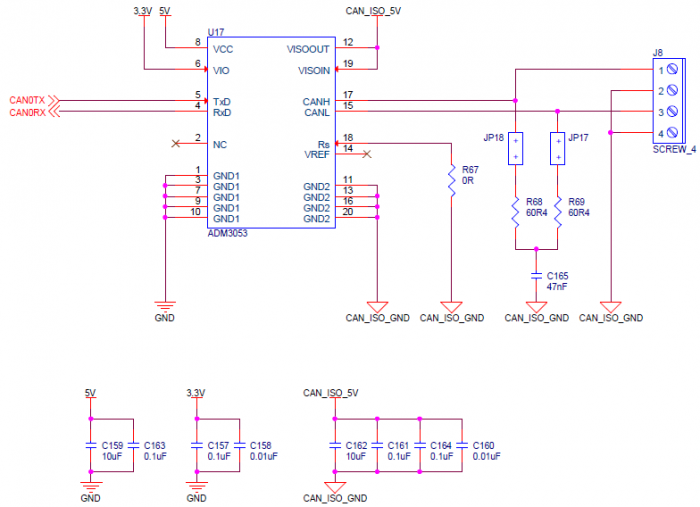 This version (03 Jan 2021 22:10) was approved by Robin Getz.The Previously approved version (28 May 2012 12:48) is available.
This version (03 Jan 2021 22:10) was approved by Robin Getz.The Previously approved version (28 May 2012 12:48) is available.
This is an old revision of the document!
ezLINX™ iCoupler® Isolated Interface Development Environment Homepage
The Isolated CAN port on the ezLINX Development Environment is implemented using the ADM3053 Signal and Power Isolated CAN transceiver. The ADM3053 connects to CAN0 of the ADSP-BF548 and is capable of functioning at data rates of up to 1Mbit/s. Figure 1 below is a circuit diagram of the implementation of the ADM3053 on the ezLINX hardware.

The CAN Node can be configured using jumpers JP17 and JP18. When both jumpers JP17 and JP18 are fitted, the CAN node is split terminated with 120Ω and a common mode capacitor of 47nF. If termination is not required, remove JP17 and JP18. A list of jumper configurations for all the interfaces on ezLINX can be found here.
The 5V supply is connected to VCC (pin 8) to power the isoPower isolated Power supply of the ADM3053. This generates an isolated 5V on the Visoout pin (pin 12) of the ADM3053 and needs to is connected to the Visoin pin(pin 19). The 3.3V supply is connected to the VIO pin (pin 6) to power the iCoupler signal isolation, which needs to be compatible with the 3.3V logic of the Blackfin ADSP-BF548. The RS pin (pin 18) is connected through a 0Ω resistor to CAN_ISO_GND in order to de-activate slew rate limiting.
A four pin screw terminal connector, J8, is used for easy access to the CANH (Pin 1), CANL (Pin 3) and CAN_ISO_GND(Pin 2 and 4) connections. Application note AN-1123 provides more information on implementing CAN Nodes.